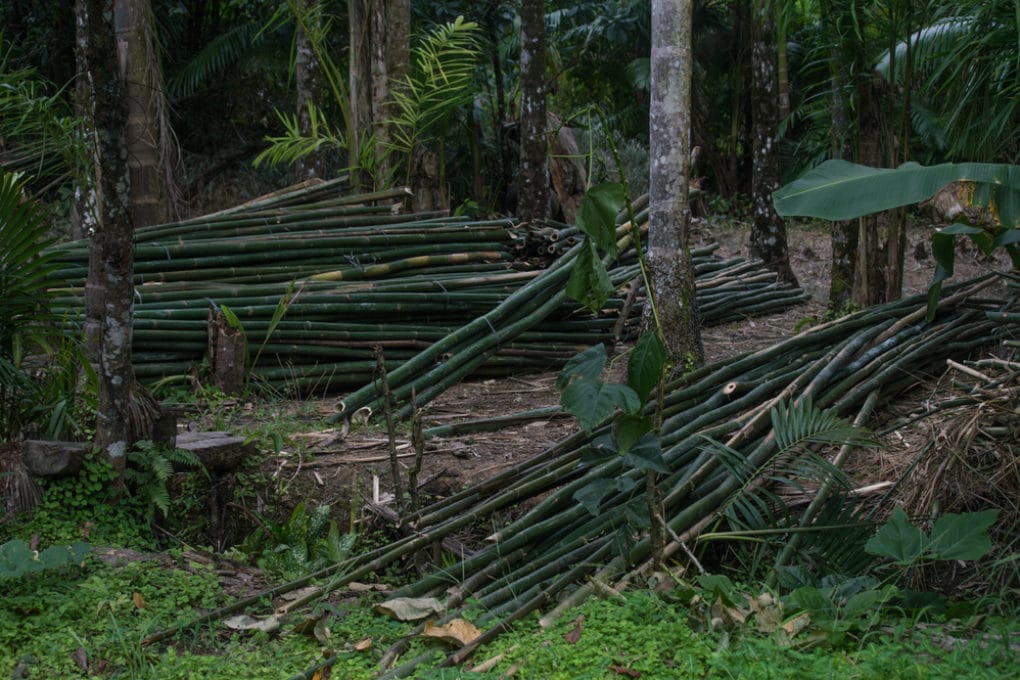How Do You Kill Bamboo: A Comprehensive Guide To Tackling This Tenacious Plant
So, you've got a bamboo problem, huh? Whether it's invading your yard or taking over your neighbor's garden, bamboo can be a persistent and tricky plant to deal with. If you're wondering how do you kill bamboo, you're not alone. Many homeowners and gardeners face this challenge, and finding a solution isn't always easy. But don’t worry, we’ve got your back! In this guide, we’ll explore the ins and outs of bamboo removal and help you reclaim your space.
Bamboo is one of those plants that can either be your best friend or your worst enemy. On one hand, it's beautiful, fast-growing, and provides excellent privacy. On the other hand, if left unchecked, it can spread like wildfire and become a nightmare to control. Before you grab the nearest ax or chemical spray, it's important to understand what you're dealing with. Bamboo comes in two main types: running bamboo and clumping bamboo. Running bamboo is the real troublemaker because it spreads aggressively through underground rhizomes, making it notoriously difficult to eliminate.
This guide isn’t just about killing bamboo; it’s about understanding why bamboo behaves the way it does and how to tackle it effectively without causing unnecessary damage to your yard or the environment. By the end of this article, you’ll have all the tools and knowledge you need to take on this green invader and restore peace to your garden. Let’s dive in!
Read also:Unveiling The Secrets Of Sexy Video Picture Open Your Ultimate Guide
Table of Contents:
- Understanding Bamboo: Types and Behavior
- Manual Removal: The Hard Way
- Chemical Solutions: Effective but Risky
- Natural Methods: Eco-Friendly Alternatives
- Preventing Regrowth: Tips and Tricks
- Tools and Equipment You’ll Need
- Common Mistakes to Avoid
- When to Call a Professional
- FAQ: Frequently Asked Questions
- Conclusion: Wrapping It All Up
Understanding Bamboo: Types and Behavior
Bamboo might look harmless, but beneath its surface lies a complex root system that can wreak havoc on your garden. To effectively kill bamboo, you need to understand its anatomy and growth patterns. There are two primary types of bamboo: running bamboo and clumping bamboo.
Running Bamboo: The Enemy
Running bamboo is the one you really need to watch out for. These plants spread rapidly through underground rhizomes, which are essentially horizontal stems that grow horizontally. These rhizomes can travel far and wide, popping up in places you least expect. If you’ve ever seen bamboo sprouting in a neighbor’s yard or even your driveway, chances are it’s running bamboo.
Clumping Bamboo: The Friendlier Option
Clumping bamboo, on the other hand, is much easier to manage. Instead of spreading aggressively, it grows in tight clusters. While it can still be a nuisance if left unchecked, it’s far less invasive than running bamboo. If you’re dealing with clumping bamboo, you might have an easier time controlling it.
Knowing the type of bamboo you’re dealing with is crucial because it will dictate the methods you use to kill it. Running bamboo requires more aggressive tactics, while clumping bamboo can often be managed with less effort.
Manual Removal: The Hard Way
If you’re the DIY type and don’t want to rely on chemicals, manual removal is an option. However, this method requires a lot of physical labor and patience. Here’s how you can do it:
Read also:Is Sydney Sweeney In Handmaids Tale The Untold Story Behind Her Connection
- Digging It Out: The first step is to dig up as much of the bamboo as possible. Use a shovel or pickaxe to dig deep into the soil and remove the rhizomes. Be thorough—any rhizomes left behind can sprout new shoots.
- Cutting the Stems: Once you’ve dug out the main plant, cut the remaining stems as close to the ground as possible. This will prevent new growth from emerging.
- Starving the Roots: After cutting the stems, cover the area with a thick layer of mulch or black plastic. This will block sunlight and eventually kill the roots.
Manual removal is effective but time-consuming. If you have a large area to cover, this method might not be practical. However, it’s a great option if you’re looking for a chemical-free solution.
Chemical Solutions: Effective but Risky
Chemicals can be a quick and effective way to kill bamboo, but they come with their own set of risks. Glyphosate-based herbicides are commonly used for bamboo control, but you need to apply them carefully to avoid harming other plants.
Steps for Chemical Treatment
- Cut the Stems: Start by cutting the bamboo stems as close to the ground as possible.
- Apply Herbicide: Paint the herbicide directly onto the cut stems. This ensures the chemical is absorbed into the root system.
- Repeat as Needed: It may take several applications to completely kill the bamboo, so be patient and persistent.
While chemical solutions can be effective, they should be used as a last resort. Always follow the instructions on the label and take precautions to protect yourself and the environment.
Natural Methods: Eco-Friendly Alternatives
If you’re looking for a more natural approach, there are several methods you can try. These methods might take longer, but they’re gentler on the environment.
Vinegar and Salt
A mixture of vinegar and salt can be an effective natural herbicide. Simply mix equal parts white vinegar and salt, and pour the solution onto the bamboo stems. This will dry out the plant and eventually kill it.
Boiling Water
Boiling water is another simple and effective method. Pour boiling water directly onto the bamboo shoots. This will scorch the plant and prevent it from growing back.
These natural methods are great for small areas, but they may not be as effective for larger infestations. If you’re dealing with a significant bamboo problem, you might need to combine these methods with others for the best results.
Preventing Regrowth: Tips and Tricks
Once you’ve killed the bamboo, the last thing you want is for it to come back. Here are some tips to prevent regrowth:
- Install a Barrier: If you’re dealing with running bamboo, consider installing a physical barrier around the area. A plastic or metal barrier buried at least 30 inches deep can prevent rhizomes from spreading.
- Mulch Heavily: Cover the area with a thick layer of mulch to block sunlight and prevent new shoots from emerging.
- Regular Monitoring: Keep an eye on the area and remove any new shoots as soon as they appear. Consistent maintenance is key to keeping bamboo at bay.
Prevention is just as important as removal. By taking these steps, you can ensure that your garden remains bamboo-free for the long term.
Tools and Equipment You’ll Need
Having the right tools can make a big difference when it comes to bamboo removal. Here’s a list of essential tools and equipment:
- Shovel: For digging out rhizomes.
- Pickaxe: For breaking up hard soil.
- Loppers or Pruners: For cutting bamboo stems.
- Gloves: To protect your hands from sharp edges.
- Herbicide: If you’re using chemical solutions.
Investing in quality tools will make the job easier and more efficient. Don’t skimp on this step—it’s worth it in the long run.
Common Mistakes to Avoid
Even the best-laid plans can go wrong if you make common mistakes. Here are a few to watch out for:
- Not Removing All Rhizomes: Leaving even a small piece of rhizome behind can lead to regrowth.
- Using Too Much Chemical: Overusing herbicides can harm other plants and the environment.
- Ignoring Prevention: Failing to take preventive measures can result in bamboo coming back with a vengeance.
By avoiding these mistakes, you can increase your chances of successfully eliminating bamboo from your yard.
When to Call a Professional
Let’s face it—sometimes bamboo removal is just too much for one person to handle. If you’ve tried everything and the bamboo keeps coming back, it might be time to call in the professionals. A professional bamboo removal service has the expertise and equipment to tackle even the toughest infestations.
FAQ: Frequently Asked Questions
Here are some common questions about bamboo removal:
- Can bamboo grow back after cutting it? Yes, bamboo can grow back unless the rhizomes are completely removed or treated with herbicide.
- Is bamboo harmful to other plants? Running bamboo can crowd out other plants and disrupt the ecosystem of your garden.
- How long does it take to kill bamboo? It can take several weeks to months, depending on the method used and the size of the infestation.
These FAQs should help clarify any lingering questions you might have about bamboo removal.
Conclusion: Wrapping It All Up
Killing bamboo might seem like a daunting task, but with the right approach, it’s definitely doable. Whether you choose manual removal, chemical solutions, or natural methods, the key is persistence and patience. By understanding the type of bamboo you’re dealing with and taking preventive measures, you can reclaim your yard and enjoy a bamboo-free space.
So, what are you waiting for? Grab your tools and get to work! And don’t forget to share this article with your friends and family who might be struggling with the same problem. Together, we can take down this green invader one step at a time.


